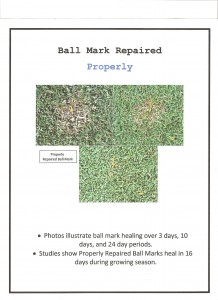With the golf course opening soon, now is the perfect opportunity to talk about, “How to properly repair a ball mark.”
Repairing Ball Marks
Repairing ball marks on greens is always a hot topic, and with the anticipated amount of opening rounds we’ll be experiencing, repairing ball marks will be a must. There are a million different ideas and tools for repairing them, but the most important thing is to do it correctly. The most common mistake made when repairing a ball mark is extending the repair tool too deeply into the green. Doing this, and then lifting or twisting harshly, leaves exposed soil with damaged plants on the ball mark perimeter, and results in an unsightly ball mark. Ball marks can be fixed with just about any repair tool following these four simple rules:
- Always push your ball marks back toward the center and do not lift or twist harshly.
- Shorten the prong length of the tool to no more than ½” to ¾” deep into the green when repairing the mark.
- Push the ball mark from the back side of the divot to the front, first, where the most displacement of turf has occurred.
- Push the ball mark from the sides to the center. The second most displaced turf occurs from the sides of the divot.
Once the back and sides of the divots have been pushed to the center, the repair is complete. With a little tapping of the putter to smooth the surface, you are ready to sink your putt. Repairing ball marks in this fashion will ensure the least amount of damage to the turf plants and offer the best playing surface. Again there are a million different ideas and tools but everything relates to simply repairing the ball mark and repairing it correctly.
Study of Ball Marks
A university study has shown that a properly repaired ball mark will heal (in the growing season) in approximately 16 days. A improperly repaired ball mark will heal (in the growing season) approximately 38 days. Improperly repaired ball marks take 43% longer to heal than properly repaired ball marks. These ball mark recovery postings are posted in various areas around the club, for example in all bathrooms on the course.
Filling Divots
When the course reopens we anticipate a lot of play, and filling divots with sand is going to be crucial to the turf plants. To ensure a smooth playing surface for each group, every divot must be filled to the top with sand and smoothed over with a club or foot on tees, fairways and roughs. Filling the divots will help protect the Bermuda grass roots, which are damaged when a divot is made.


